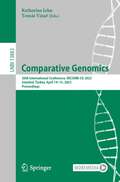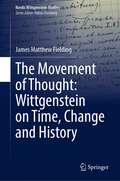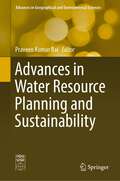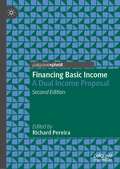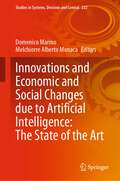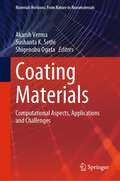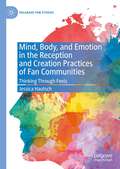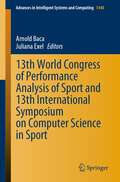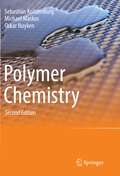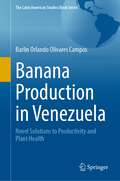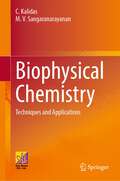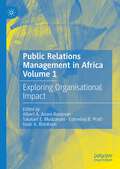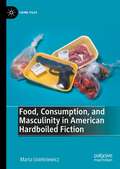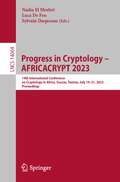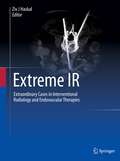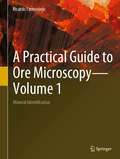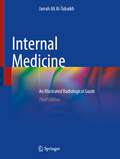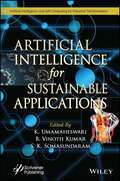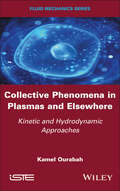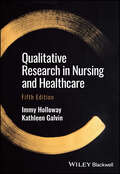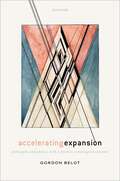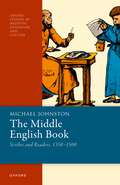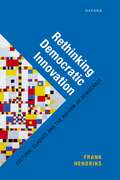- Table View
- List View
Comparative Genomics: 20th International Conference, RECOMB-CG 2023, Istanbul, Turkey, April 14–15, 2023, Proceedings (Lecture Notes in Computer Science #13883)
by Katharina Jahn Tomáš VinařThis book constitutes the refereed proceedings of the 20th Annual RECOMB Satellite Workshop on Comparative Genomics, RECOMB-CG 2023 which took place in Istanbul, Turkey, in April 2023. The 15 full papers included in this book were carefully reviewed and selected from 25 submissions. The papers present cutting edge research in comparative genomics, with an emphasis on computational approaches and novel experimental results.Chapters "Inferring Clusters of Orthologous and Paralogous Transcripts" and "Gene Order Phylogeny via Ancestral Genome Reconstruction under Dollo" are published Open Access under Creative Commons Attribution license (CC BY 4.0).
The Movement of Thought: Wittgenstein on Time, Change and History (Nordic Wittgenstein Studies #9)
by James Matthew FieldingThis book covers the topic of history and the role that it played in the Austrio-British philosopher Ludwig Wittgenstein’s thought. The topic is explored from multiple angles, both chronologically and thematically. Reviewing Wittgenstein’s two magnum opera - the Tractatus Logico-Philosophicus (1921) and Philosophical Investigations (1952), this work is an investigation into an under-acknowledged element in Wittgenstein’s thought, one which in many cases acted as an impetus for that life-long process of novel philosophical reflection: History.This volume traces the evolution of Wittgenstein’s thoughts on time and temporality from the Tractatus, through the Investigations, into some key post-Investigations remarks and also examines the motivations behind Wittgenstein’s post-Tractarian return to philosophy and, in particular, the unique methodology he developed in order to serve his renewed purpose. The final chapter seeks to answer the question, What was Wittgenstein trying to achieve with Philosophical Investigations? This book is of interest to philosophers.
Advances in Water Resource Planning and Sustainability (Advances in Geographical and Environmental Sciences)
by Praveen Kumar RaiSustainable water resources planning deals with the interface of water resources science and the needs of human populations. It highlights works that addresses practical methods and basic research in, for example: quantity and quality management of groundwater and surface water resources; sustainability of water resources and water availability; water use and reuse including managed aquifer recharge and storage; geopolitical and socio-economic aspects of water resource management; water development and human activity impacts on ecological systems and human health, including, for instance, agricultural and climatic impacts, subsurface waste storage and injection, geothermal energy development and subsurface energy storage. This book provides up-to-date systematic and scientific analyses of such water problems and suggests sustainable measures to overcome them through effective surface and sub-surface water resource management. It is immensely valuable to students, researchers, water resource managers, hydrologists and all those who are engaged or interested in any aspect of river water conservation and management of water resources.
Financing Basic Income: A Dual Income Proposal (Exploring the Basic Income Guarantee)
by Richard PereiraThis Palgrave Pivot second edition argues that basic income is, in fact, affordable. The contributors approach the topic from the perspectives of three different countries—Canada, Switzerland, and Australia—to overcome objections that a universal program to keep all citizens above the poverty line would be too expensive to implement. They assess the complex array of revenue sources that can make universal basic income feasible, from the underestimated value of public program redundancies to new and so far, unaccounted publicly owned assets.This new edition adds an analysis for financing basic income in the United States, as well as considering the basic income potential in a country of far more modest economic resources, Portugal. The COVID-19 pandemic is discussed in a new Prologue, demonstrating the need for universal economic security as a precautionary measure for unforeseen crises. New research and compelling analyses are included throughout, to provide support for a dual basic income proposal.
Innovations and Economic and Social Changes due to Artificial Intelligence: The State of the Art (Studies in Systems, Decision and Control #222)
by Domenico Marino Melchiorre Alberto MonacaThe book aims to deal with the main advances in the study of artificial intelligence, the digital and circular economy, and innovation from a multidisciplinary perspective. Whoever governs the artificial intelligence will hold the keys to the world and the future. This book explains the growing role of artificial intelligence in our lives and the need to understand its mechanisms. The book presents original research articles addressing various aspects of artificial intelligence applied to economics, law, management, and optimization. The topics discussed include economics, territorial policies, law, resource allocation strategies, information technology, and learning for inclusion. Combining the input of contributing professors and researchers from Italian and other foreign universities, the book is of interest to students, researchers, and practitioners, as well as members of the public in general, interested in the world of the artificial intelligence and economics.
Coating Materials: Computational Aspects, Applications and Challenges (Materials Horizons: From Nature to Nanomaterials)
by Akarsh Verma Sushanta K. Sethi Shigenobu OgataThis book comprehensively reviews assorted types of coatings, their applications, and various strategies employed by several scientists and researchers to fabricate them. Exclusively, the recent progress in computational strategies that are helpful to optimize the best suitable coating formulation before one goes for the real-time fabrication has been discussed in detail. And this book is also intended to shed light on the computational modeling techniques that are used in the characterization of various coating materials. It covers mechanisms, salient features, formulations, important aspects, and case studies of coatings utilized for various applications. The latest research in this area as well as possible avenues of future research is also highlighted to encourage the researchers.
Mind, Body, and Emotion in the Reception and Creation Practices of Fan Communities: Thinking Through Feels (Palgrave Fan Studies)
by Jessica HautschThis book argues that fans’ creative works form a cognitive system; fanfic, fanvids, and gifs are not simply evidence of thinking, but acts of thinking. Drawing on work in cognitive linguistics, neuroscience, cognitive philosophy, and psychology—particularly focused on 4-E cognition, which rejects Cartesian dualism–this project demonstrates that cognition is an embodied, emotional, and distributed act that emerges from fans’ interactions with media texts, technological interfaces, and fan collectives. This mode of textual engagement is deeply physical, emotional, and social and is enacted through fanworks. By developing a theory of critical closeness, this book proposes a methodology for fruitfully putting cognitive science in conversation with fan studies.
13th World Congress of Performance Analysis of Sport and 13th International Symposium on Computer Science in Sport (Advances in Intelligent Systems and Computing #1448)
by Arnold Baca Juliana ExelThis book discovers the latest research and insights in sports performance analysis and computer science in sports with the 13th World Congress of Performance Analysis of Sport and 13th International Symposium on Computer Science in Sport joint conference proceedings. This comprehensive book features over 40 peer-reviewed scientific works, showcasing the latest developments in these areas. The book covers a wide range of topics, including data analytics in sports, performance tracking and monitoring, artificial intelligence and machine learning in sports, virtual and augmented reality in sports, sensor technology, sports biomechanics, and motor control. By reading this book, you'll gain a deeper understanding of how applied and research-based problems can, together, transform the world of sports, and how you can stay ahead of the curve in this rapidly evolving field. This means that whether you're a researcher, coach, athlete, or sports enthusiast, there is something for everyone in this book.
Polymer Chemistry
by Sebastian Koltzenburg Michael Maskos Oskar NuykenAwarded the Literature Prize of the VCI This comprehensive textbook describes the synthesis, characterization and technical and engineering applications of polymers. Polymers are unique molecules and have properties different from any other class of materials. We encounter them in everyday life, not only in the form of the well-known, large-volume plastics such as PE or PP or the many other special polymers, some of which are very specifically modified but also in nature as polymeric biomolecules, such as DNA. Our life, as we know it, would not only be completely different without macromolecules but it would also be biologically impossible. This textbook provides a broad knowledge of the basic concepts of macromolecular chemistry and the unique properties of this class of materials. Environmentally relevant topics, such as biopolymers and microplastic, which should not be missing in a contemporary textbook are also covered. Building on basic knowledge of organic chemistry and thermodynamics, the book presents an easy-to-understand yet in-depth picture of this very dynamic and increasingly important interdisciplinary science that involves elements of chemistry, physics, engineering, and the life sciences. Readers of this work can confirm their understanding of the text at the end of each chapter by working through a selection of exercises. In writing the book, great importance was attached to good readability despite the necessary depth of detail. It is a book that is just as suitable for students of chemistry and related courses as it is for the applied scientist in an industrial environment. The first edition of this work is so far the only textbook on polymer chemistry to be awarded the Literature Prize of the Fund of the German Chemical Industry Association in 2015.
Banana Production in Venezuela: Novel Solutions to Productivity and Plant Health (The Latin American Studies Book Series)
by Barlin Orlando Olivares CamposThis book presents an important contribution to the knowledge of the banana soils of Venezuela. Banana, the edible fruit of Musaceae, is a staple food for more than 400 million people worldwide due to their nutritional and energy attributes. This makes Musaceae a crop of worldwide relevance, particularly in tropical regions, highlighting the impact of improved Musaceae cropping systems in the current efforts worldwide oriented towards a new agricultural revolution based on sustainable intensification. To achieve this, better practices for food production based on scientific and technical research capable to consider the complexity and variability within the agri-food sector are necessary. The research presented in this book is oriented towards providing answers to the causes of two aspects considered of high relevance for banana production, both affecting productivity and sustainability, always addressed for the Venezuelan conditions, one of the world’s largest producing countries: 1- The impact of phytosanitary risks related to Fusarium Wilt (FW) and the influence of the soil on the incidence of Banana Wilt (BW); and 2- An observed trend towards loss of productivity and decline of soil quality in some commercial farms of Aragua and Trujillo states in Venezuela. The book presents a pioneering study in the application of categorical regression (CATREG) in the characterization of banana soils and analyses soil morphological variables, such as texture, dry consistency, biological activity, reaction to HCl, and type of structure to characterize soil productivity for growing healthy bananas. It develops, for the first time in Venezuela, risk analysis and climatic suitability maps for lethal wilt disease in bananas caused by Fusarium oxysporum f. sp. cubense (Foc) Tropical Race 4 (TR4) (syn. Fusarium odoratissimum). Innovative machine learning techniques are used to predict BW so that future crop development can be done more efficiently and sustainably.
Biophysical Chemistry: Techniques and Applications
by C. Kalidas M.V. SangaranarayananThe textbook is intended for the undergraduate and postgraduate students of chemistry, biology and medicine. It covers diverse topics of biophysical chemistry ranging from the structure of cells, lipids, and proteins to nonequilibrium thermodynamics, enzyme catalysis, and fast reaction kinetics. The book discusses the fundamental structural concepts in the first part and provides a systematic account of different experimental techniques such as chromatography, electrophoresis, and gel filtration that are extensively employed in biochemical research in the second part. It also includes typical applications using NMR, ESR, and SPR to comprehend the power of spectroscopic tools in biophysical chemistry. This textbook also deals with advanced topics of entropy production and biosensors. It consists of a large number of schematic diagrams as well as tabular compilations of kinetic, electrochemical, and thermochemical data. It includes multiple-choice questions, numerical examples, and descriptive questions in various chapters to aid self-learning among students. In view of the diverse coverage of topics, this textbook is a valuable asset to undergraduate and postgraduate students. It is also a useful reference for researchers and professionals in chemistry, biology, and medicine.
Public Relations Management in Africa Volume 1: Exploring Organisational Impact
by Albert A. Anani-Bossman Takalani E. Mudzanani Cornelius B. Pratt Isaac A. BlanksonThis two-part volume examines current pedagogical modules, research directions and other emerging issues in public relations and communication management in Africa. In comparison to its Western and Asian counterparts, the literature on public relations management in Africa is limited, and much of it is examined through the lenses of Western philosophies and pedagogies that do not generally resonate with Africa's socioeconomic, political, and cultural contexts. This book aims to change that. Through analyzing the organizational dynamic, Volume 1 brings together contributors from across Africa to provide valuable insights into how public relations contributes to organizational effectiveness on the continent. Chapters discussed include a review of public relations research in Africa, the role of the African CEO as a public relations activist, the use of social and digital media in public relations, the measurement and evaluation of communication programs, and the implications of the fourth industrial revolution on public relations practice in Africa. Providing important pathways and overviews of public relations management in Africa, this volume not only highlights current practices but offers insights into the future of the practice within its evolving global landscape.
Food, Consumption, and Masculinity in American Hardboiled Fiction (Crime Files)
by Marta UsiekniewiczFood, Consumption, and Masculinity in American Hardboiled Fiction draws on three related bodies of knowledge: crime fiction criticism, masculinity studies, and the cultural analysis of food and consumption practices from a critical eating studies perspective. In particular, this book focuses on food as an analytical category in the study of tough masculinity as represented in American hardboiled fiction. Through an examination of six American novels: Dashiell Hammett's The Maltese Falcon, Raymond Chandler's The Big Sleep, Leigh Brackett's No Good from a Corpse, Dorothy B. Hughes's In a Lonely Place, Jim Thompson's The Killer Inside Me, and Rex Stout's Champagne for One, this book shows how these novels reflect the gradual process of redefining consumption and consumerism in America, which traditionally has been coded as feminine. Marta Usiekniewicz shows that food and eating also reflect power relations and larger social and economic structures connected to class, gender, geography, sexuality, and ability, to name just a few.
Progress in Cryptology - AFRICACRYPT 2023: 14th International Conference on Cryptology in Africa, Sousse, Tunisia, July 19–21, 2023, Proceedings (Lecture Notes in Computer Science #14064)
by Nadia El Mrabet Luca De Feo Sylvain DuquesneThis volume contains the papers accepted for presentation at Africacrypt 2023, the 14th International Conference on the Theory and Application of Cryptographic Techniques in Africa. The 21 full papers included in this book were carefully reviewed and selected from 59 submissions. They were organized in topical sections as follows: Post-quantum cryptography; Symmetric cryptography; Cryptanalysis; Blockchain; Lattice-based cryptography; Implementations; Theory.
Extreme IR: Extraordinary Cases in Interventional Radiology and Endovascular Therapies
by Ziv J HaskalThis book presents 101 unique and extraordinary cases in interventional radiology (IR) and endovascular therapy. Extreme IR is an internationally recognized event that Dr. Ziv Haskal created and held in early 2000's at mountaintop venues, then at successive Society of Interventional Radiology annual conference meetings, and later, published monthly within the Journal of Vascular and Interventional Radiology (JVIR) for which he was editor-in-chief for 10 years. The ever-popular Extreme IR sessions at conferences have drawn more than 5,000 attendees. Cases are presented in a rapid-fire format designed to maximize relevancy, excitement, and unique knowledge. This book aims to replicate that experience for a wider audience. The book is divided into twelve sections, including venous, portal hypertension, and biliary, arterial, oncology, etc. cases. Most cases span two pages and include large, illustrative images with bullet-pointed text to present essential information in a concise and focused fashion. The global list of authors exemplifies the extraordinary breadth of the cases for interventional radiologists, endovascular specialists. It is ideal for interventional radiologists and endovascular specialists at all levels of seniority and training.
A Practical Guide to Ore Microscopy—Volume 1: Mineral Identification
by Ricardo CastroviejoThis book offers a guide to the microscopic study of metallic ores with reflected light. It combines a rigorous approach with an attractive and easy-to-follow format, using high-quality calibrated photomicrographs to illustrate the use of color for ore identification. The ore identification methodology is updated with systematic color analysis and the application of new multispectral reflectance datasets, which offer an efficient tool for automated ore characterization. In addition, the first volume of this two-part work discusses the essential gangue minerals.Readers will gain familiarity with the method as they follow its application to over 200 selected minerals, comprising the most important ore (≈150) and gangue (≈50) minerals, which are described in the text. Each entry includes an explanatory text with corresponding color photomicrographs for each of the most common microscope settings, preceded by a table summarizing the ore’s main properties, and followed by spectral information in the visible and near-infrared ranges (specular reflectance values from 370 to 1000 nm). Some uncommon, strategic ores, e.g. columbotantalite (“coltan”) and monazite, receive particular attention or are described for the first time with reflected light.Lastly, the book presents a learning strategy for beginners and students. The approach is essentially practical, focusing on the development of observation skills, including self-checking through proposed practical tasks. In addition, the traditional use of determinative tables is critically reviewed and updated.This book is part of a two-volume work. The second volume focuses on intergrowths/textural analysis and interpretation, as well as computer-vision-based automation and applications to ore processing/geometallurgy.The intended audience includes professionals and engineers dealing with mineral resources, as well as postgraduate students. The book also provides lifelong learning support for freelancers and a valuable reference resource for practical university teaching.
Internal Medicine: An Illustrated Radiological Guide
by Jarrah Ali Al-TubaikhThis very well-received book, now in its third edition, equips the radiologist with the information needed in order to diagnose internal medicine disorders and their complications from the radiological perspective. It offers an easy-to-consult tool that documents the most common and most important radiological signs of a wide range of diseases, across diverse specialties, with the aid of an excellent gallery of images and illustrations. Compared with the second edition, new updates have been added, including three new chapters that cover autonomic medicine, psychosomatic medicine, and forensic medicine. Internal Medicine – An Illustrated Radiological Guide puts the radiologist in the internal medicine physician’s shoes. It teaches radiologists how to think in terms of disease progression and complications, explains where to look for and to image these complications, and identifies the best modalities for reaching a diagnosis. It will also benefit internal medicine physicians by clarifying the help that radiology can offer them and assisting in the choice of investigation for diagnostic confirmation.
Artificial Intelligence for Sustainable Applications (Artificial Intelligence and Soft Computing for Industrial Transformation)
by K. Umamaheswari B. Vinoth Kumar S. K. SomasundaramARTIFICAL INTELLIGENCE for SUSTAINABLE APPLICATIONS The objective of this book is to leverage the significance of artificial intelligence in achieving sustainable solutions using interdisciplinary research through innovative ideas. With the advent of recent technologies, the demand for Information and Communication Technology (ICT)-based applications such as artificial intelligence (AI), machine learning (ML), Internet of Things (IoT), health care, data analytics, augmented reality/virtual reality, cyber-physical systems, and future generation networks, has increased drastically. In recent years, artificial intelligence has played a more significant role in everyday activities. While AI creates opportunities, it also presents greater challenges in the sustainable development of engineering applications. Therefore, the association between AI and sustainable applications is an essential field of research. Moreover, the applications of sustainable products have come a long way in the past few decades, driven by social and environmental awareness, and abundant modernization in the pertinent field. New research efforts are inevitable in the ongoing design of sustainable applications, which makes the study of communication between them a promising field to explore. This book highlights the recent advances in AI and its allied technologies with a special focus on sustainable applications. It covers theoretical background, a hands-on approach, and real-time use cases with experimental and analytical results. Audience AI researchers as well as engineers in information technology and computer science.
Collective Phenomena in Plasmas and Elsewhere: Kinetic and Hydrodynamic Approaches
by Kamel OurabahThe Universe is made up of systems consisting of a very large number of particles interacting in a very complex way. When studying these systems, a precise microscopic approach is unattainable. In practice, the best strategy is one that is able to “distinguish” between superfluous information and the information needed to make predictions about the evolution of the system. There are two main competing approaches: kinetic and hydrodynamic. Collective Phenomena in Plasmas and Elsewhere presents an overview of the theoretical bases of these kinetic and hydrodynamic approaches, but also discusses their limitations, the links between them and their extension to quantum mechanics and relativity. These methods were born in part out of the study of plasmas, but they also have more universal applications. A general framework for these approaches is outlined, followed by some applications in plasmas, gravitation, Bose–Einstein condensates and dark matter. Particular emphasis is placed on the analogies that can be made between all these different systems.
Qualitative Research in Nursing and Healthcare
by Immy Holloway Kathleen GalvinQualitative Research in Nursing and Healthcare Discover how to conduct qualitative nursing research with confidence Co-authored by experienced researchers, Qualitative Research in Nursing and Healthcare offers practical and applied examples for those who carry out qualitative research in the healthcare arena. With clear explanations of abstract ideas and practical procedures, this updated edition incorporates recent examples in nursing research and developments in the qualitative field, providing readers with the latest approaches and techniques for gaining insight into people’s attitudes, behaviours, value systems, concerns, motivations, aspirations, culture and lifestyles. From ethnographies to action research, readers will find explorations of data collection, sampling and analysis, including discussions of: Interviewing and participant observation, strategies, and procedures Trustworthiness and validity, and ensuring the credibility of qualitative research A variety of approaches in qualitative research, such as grounded theory, phenomenology and narrative inquiry Whether you’re a postgraduate nursing student, a third-year nursing student on a pre-registration nursing programme, or a qualified nursing and healthcare staff member, Qualitative Research in Nursing and Healthcare is the perfect resource to help you conduct meaningful research with confidence.
Accelerating Expansion: Philosophy and Physics with a Positive Cosmological Constant
by Prof Gordon BelotAccelerating Expansion explores some of the philosophical implications of modern cosmology, focused on the significance that the discovery of the accelerating expansion of the Universe has for our understanding of time, geometry, and physics. The appearance of the cosmological constant in the equations of general relativity allows one to model universes in which space has an inherent tendency towards expansion. This constant, introduced by Einstein but subsequently abandoned by him, returned to centre stage with the discovery of the accelerating expansion. This pedagogically-oriented essay begins with a study of the most basic and elegant relativistic world that involves a positive cosmological constant, de Sitter spacetime. It then turns to the relatives of de Sitter spacetime that dominate modern relativistic cosmology. Some of the topics considered include: the nature of time and simultaneity in de Sitter worlds; the sense in which de Sitter spacetime is a powerful dynamical attractor; the limited extent to which observation can give us information about the topology of space in a world undergoing accelerated expansion; and cosmologists' favourite sceptical worry about the reliability of evidence and the possibility of knowledge, the problem of Boltzmann brains.
The Middle English Book: Scribes and Readers, 1350-1500 (Oxford Studies in Medieval Literature and Culture)
by Prof Michael JohnstonThe monograph series Oxford Studies in Medieval Literature and Culture showcases the plurilingual and multicultural quality of medieval literature and actively seeks to promote research that not only focuses on the array of subjects medievalists now pursue—in literature, theology, and philosophy, in social, political, jurisprudential, and intellectual history, the history of art, and the history of science—but also that combines these subjects productively. It offers innovative studies on topics that may include, but are not limited to, manuscript and book history; languages and literatures of the global Middle Ages; race and the post-colonial; the digital humanities, media and performance; music; medicine; the history of affect and the emotions; the literature and practices of devotion; the theory and history of gender and sexuality, ecocriticism and the environment; theories of aesthetics; medievalism. The Middle English Book addresses a series of questions about the copying and circulation of literature in late medieval England: How do we make sense of the variety of manuscripts surviving from this period? Who copied and disseminated these diverse manuscripts? Who read the literary texts that they transmit? And what was the relationship between those copying literature and those reading it? To answer these questions, this book examines 202 literary manuscripts from the period 1350 to 1500. First, this study suggests that most surviving manuscripts fall into four categories, depending on the proximity and relationship of that manuscript's scribes and readers. But beyond proposing these new categories, this book also looks at the history of writing practices, and demonstrates the ubiquity of bureaucracies within late medieval England. As a result, The Middle English Book argues that literary production was a decentered affair, one that took place within these numerous, modest, yet complex, bureaucracies. But this book also argues that, because literary production arose in such scattered bureaucracies, manuscripts were local products, produced within the cultural and economic milieu of their users. Manuscripts thus form a fundamentally different sort of cultural artefact than the printed books with which we are familiar—a form of centralized, urbanized, and commercialized textual production that was just over the historical horizon in late medieval England.
The Middle English Book: Scribes and Readers, 1350-1500 (Oxford Studies in Medieval Literature and Culture)
by Prof Michael JohnstonThe monograph series Oxford Studies in Medieval Literature and Culture showcases the plurilingual and multicultural quality of medieval literature and actively seeks to promote research that not only focuses on the array of subjects medievalists now pursue—in literature, theology, and philosophy, in social, political, jurisprudential, and intellectual history, the history of art, and the history of science—but also that combines these subjects productively. It offers innovative studies on topics that may include, but are not limited to, manuscript and book history; languages and literatures of the global Middle Ages; race and the post-colonial; the digital humanities, media and performance; music; medicine; the history of affect and the emotions; the literature and practices of devotion; the theory and history of gender and sexuality, ecocriticism and the environment; theories of aesthetics; medievalism. The Middle English Book addresses a series of questions about the copying and circulation of literature in late medieval England: How do we make sense of the variety of manuscripts surviving from this period? Who copied and disseminated these diverse manuscripts? Who read the literary texts that they transmit? And what was the relationship between those copying literature and those reading it? To answer these questions, this book examines 202 literary manuscripts from the period 1350 to 1500. First, this study suggests that most surviving manuscripts fall into four categories, depending on the proximity and relationship of that manuscript's scribes and readers. But beyond proposing these new categories, this book also looks at the history of writing practices, and demonstrates the ubiquity of bureaucracies within late medieval England. As a result, The Middle English Book argues that literary production was a decentered affair, one that took place within these numerous, modest, yet complex, bureaucracies. But this book also argues that, because literary production arose in such scattered bureaucracies, manuscripts were local products, produced within the cultural and economic milieu of their users. Manuscripts thus form a fundamentally different sort of cultural artefact than the printed books with which we are familiar—a form of centralized, urbanized, and commercialized textual production that was just over the historical horizon in late medieval England.
Rethinking Democratic Innovation: Cultural Clashes and the Reform of Democracy
by Prof Frank HendriksRethinking Democratic Innovation takes a fresh look at diverging visions of improving democratic governance and asks whether these existing tensions could be made productive. Could different visions of democratic revitalisation complement and correct each other in ways that are good for democracy? Is it conceivable that combined approaches address a larger part of the democratic challenge, while isolated approaches, centralizing deliberative or plebiscitary democracy, are confined to more limited areas of concern? This book ultimately provides an affirmative answer, outlining the scope for hybrid democratic innovations that thrive on exploiting, not eliminating, tensions between diverging visions of improved democracy. Supplementing democratic theory with a cultural perspective, this book contributes to a deeper understanding of plans and methods geared toward improving democratic governance. Revisiting Mary Douglas's seminal take on culture as pollution reduction, processes of democratic innovation are understood as instances of cultural cleaning in public governance. The book recognizes that democratic cleaning will never be finished but can be done in ways that are more productive. Reflecting on varieties of hybrid democratic innovation - deliberative referendums, participatory budgeting-new style, and more - the author posits that more versatile, connective, and embedded innovations stand a better chance of high performance on a broader spectrum than democratic innovations falling short of these qualities.
Accelerating Expansion: Philosophy and Physics with a Positive Cosmological Constant
by Prof Gordon BelotAccelerating Expansion explores some of the philosophical implications of modern cosmology, focused on the significance that the discovery of the accelerating expansion of the Universe has for our understanding of time, geometry, and physics. The appearance of the cosmological constant in the equations of general relativity allows one to model universes in which space has an inherent tendency towards expansion. This constant, introduced by Einstein but subsequently abandoned by him, returned to centre stage with the discovery of the accelerating expansion. This pedagogically-oriented essay begins with a study of the most basic and elegant relativistic world that involves a positive cosmological constant, de Sitter spacetime. It then turns to the relatives of de Sitter spacetime that dominate modern relativistic cosmology. Some of the topics considered include: the nature of time and simultaneity in de Sitter worlds; the sense in which de Sitter spacetime is a powerful dynamical attractor; the limited extent to which observation can give us information about the topology of space in a world undergoing accelerated expansion; and cosmologists' favourite sceptical worry about the reliability of evidence and the possibility of knowledge, the problem of Boltzmann brains.
